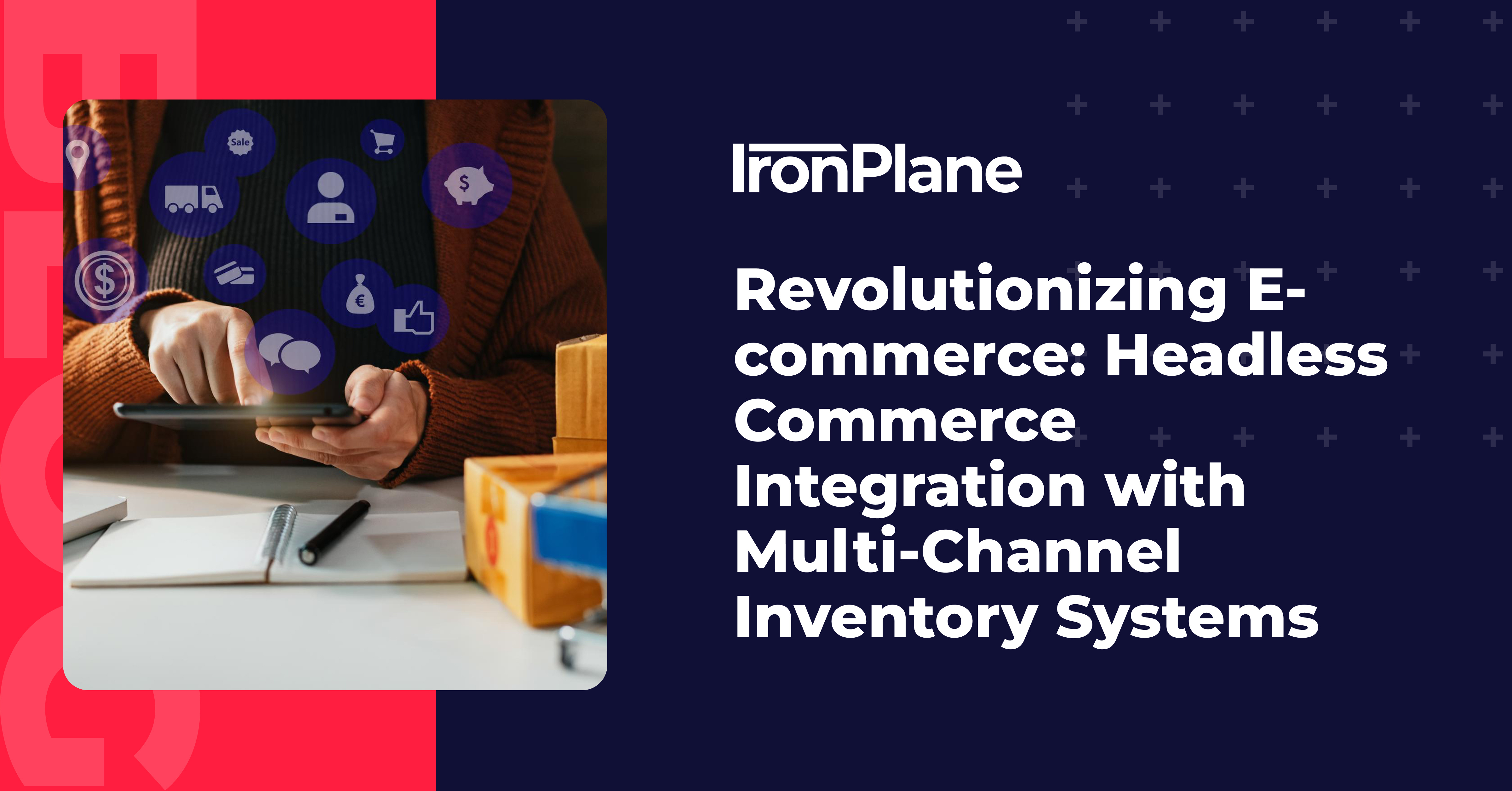Headless Commerce: Improving eCommerce Speed and Performance
In today's fast online world, eCommerce businesses are always trying to make their websites better and faster for customers.
10 min read
 Jeff Zoldy
:
February 24, 2025
Jeff Zoldy
:
February 24, 2025

In today's digital world, businesses are always looking for ways to stay ahead. One exciting development is combining headless commerce with multi-channel inventory systems. This powerful mix is changing how online stores work, giving them more flexibility, speed, and control over their websites and inventory. As online shopping keeps changing, this combination is becoming really important for businesses that want to give customers a smooth experience across all their shopping channels while keeping things running smoothly behind the scenes.
Headless commerce is a new way of setting up online stores. It separates the part of the website that customers see from the part that does all the behind-the-scenes work. This lets businesses create unique and engaging experiences for customers on different devices without being limited by traditional online store systems. Headless commerce improves e-commerce speed and performance, giving businesses an edge in the online marketplace. By separating the front and back parts, companies can use the latest technologies to create fast and interactive websites while keeping the back-end strong and able to grow.
Headless commerce has many benefits. It makes websites load faster, which is important for keeping customers interested and making them more likely to buy something. It also lets businesses quickly adapt to new technologies and what customers want without having to completely change their entire online store system. This flexibility is really valuable in today's fast-changing digital world, where new devices and platforms can become popular quickly. By using a headless approach, businesses can make sure their online stores are ready for the future and can easily change with new technology.
Multi-channel inventory systems are smart tools that help businesses keep track of their stock across different places where they sell, like online stores, marketplaces, and physical shops. These systems give a central view of all the inventory, making sure stock levels are accurate everywhere in real-time. This is really important for preventing overselling and keeping customers happy, as it stops customers from ordering things that are actually out of stock. These systems also help businesses have just the right amount of stock, reducing costs from having too much while also making sure they don't run out.
Omnichannel commerce is becoming more important as customers expect to have a smooth experience whether they're shopping online or in a store. Multi-channel inventory systems play a big role in making this possible by keeping inventory information up-to-date everywhere. These systems let businesses offer features like buying online and picking up in store, or shipping from a store, giving customers flexible options that mix the ease of online shopping with the immediacy of physical stores. By keeping accurate inventory data across all channels, businesses can create a unified shopping experience that meets the different needs and preferences of today's shoppers.
When headless commerce is combined with multi-channel inventory systems, businesses can create a powerful and flexible online shopping system that offers unprecedented control and efficiency. This integration allows for real-time inventory updates across all sales channels, ensuring that customers always see accurate stock information no matter where they're shopping. This level of synchronization is crucial for maintaining customer trust and preventing the disappointment and frustration that can arise from inaccurate inventory information.
The integration also enables businesses to create highly personalized shopping experiences based on real-time inventory data. For example, a customer browsing a product on their smartphone can see accurate stock levels and even be directed to a nearby physical store if they prefer to make the purchase in person. This level of personalization extends to marketing efforts as well, allowing businesses to tailor their promotions and recommendations based on current inventory levels and customer preferences. By leveraging the flexibility of headless commerce with the real-time accuracy of multi-channel inventory systems, businesses can create dynamic and responsive shopping experiences that adapt to individual customer needs and preferences in real-time.
Setting up a headless commerce solution integrated with multi-channel inventory systems requires careful planning and technical know-how. E-commerce consulting can be really helpful in figuring out the complexities of this integration, providing expert guidance on best practices and potential problems. Consultants can help businesses look at their current systems, identify integration challenges, and develop a strategic plan for implementation that aligns with business goals and technical capabilities.
Key technical considerations include:
It's important to work with experienced developers who understand both headless commerce architectures and inventory management systems to ensure a smooth integration. These experts can help design and implement a system that not only meets current needs but is also flexible enough to adapt to future changes in technology and business requirements. Additionally, they can assist in developing custom middleware or integration layers if needed to bridge any gaps between different systems and ensure seamless data flow.
The integration of headless commerce with multi-channel inventory systems offers numerous benefits for businesses, transforming their e-commerce operations and customer experiences:
1. Enhanced flexibility and customization: Businesses can create unique customer experiences tailored to different devices and platforms. This flexibility allows for rapid adaptation to new technologies and changing customer preferences, ensuring that the shopping experience remains cutting-edge and engaging across all touchpoints.
2. Improved website performance and speed: Headless architecture allows for faster loading times, leading to better user experiences and potentially higher conversion rates. By separating the front-end from the back-end, businesses can optimize each layer independently, resulting in lightning-fast page loads and smooth interactions that keep customers engaged and satisfied.
3. Seamless multichannel integration: Inventory data is synchronized across all sales channels, providing a consistent experience for customers. This integration eliminates discrepancies between online and offline inventory, reducing the risk of overselling and improving customer satisfaction. It also enables advanced features like real-time stock updates and cross-channel order fulfillment.
4. Future-proofing business operations: The flexibility of headless commerce makes it easier to adapt to new technologies and changing customer preferences. As new sales channels or devices emerge, businesses can quickly integrate them into their existing ecosystem without major overhauls, ensuring they stay ahead of the curve in the rapidly evolving e-commerce landscape.
While the benefits are significant, there are also challenges to consider when implementing headless commerce with multi-channel inventory systems:
1. Technical complexity: The integration requires a high level of technical expertise and may be more complex than traditional e-commerce setups. This complexity can show up in various ways, from initial implementation challenges to ongoing maintenance and troubleshooting. Businesses need to make sure they have access to skilled developers and IT professionals who can navigate these complexities effectively.
2. Initial investment: There can be significant upfront costs associated with implementing these systems. This includes not only the cost of the software and integration services but also potential hardware upgrades, staff training, and temporary disruptions to business operations during the transition. However, it's important to view this as a long-term investment that can yield substantial returns through improved efficiency and customer satisfaction.
3. Potential implementation hurdles: Businesses may face challenges in moving existing data and integrating with older systems. This can be particularly problematic for companies with a long history of online sales and complex existing systems. Careful planning and potentially phased implementation approaches may be necessary to minimize disruptions and ensure a smooth transition.
E-commerce platform selection is crucial in addressing these challenges. Choosing the right platform that supports headless commerce and integrates well with multi-channel inventory systems can make the implementation process smoother and more successful. It's important to thoroughly evaluate different platforms, considering factors such as scalability, API robustness, ecosystem of integrations, and long-term support and development roadmaps.
Many businesses have successfully implemented headless commerce integrated with multi-channel inventory systems, seeing significant improvements in their operations and customer experiences. These real-world examples show the transformative power of this integration:
For example, a large retail chain implemented this integrated approach and saw a 30% increase in online sales within the first six months. They were able to provide a consistent shopping experience across their website, mobile app, and in-store kiosks, all while maintaining accurate inventory information across all channels. This seamless integration not only improved customer satisfaction but also significantly reduced instances of overselling and stockouts. The retailer reported a 25% reduction in inventory holding costs due to more accurate stock forecasting and management.
Another success story comes from a rapidly growing e-commerce startup. By adopting a headless commerce approach integrated with a multi-channel inventory system, they were able to quickly expand into new markets and add new sales channels without disrupting their existing operations. This flexibility allowed them to double their revenue in just one year. The startup particularly benefited from the ability to quickly launch localized versions of their online store for different international markets, each with its own inventory management tailored to local demand and supply chain considerations.
Selecting the right headless commerce and multi-channel inventory solution is crucial for success. Here are some factors to consider:
1. Assess your business needs and goals: Think about your current operations and future growth plans. This includes looking at your current sales channels, plans to expand into new markets or platforms, and specific features or capabilities that are crucial for your business model. A thorough needs assessment will help ensure that the chosen solution aligns with both short-term requirements and long-term strategic objectives.
2. Evaluate technical capabilities: Make sure you have the necessary technical resources to implement and maintain the system. This includes assessing your in-house IT team's skills and potentially identifying areas where additional training or external expertise may be required. Consider the ongoing support and maintenance needs of the integrated system and how they align with your current IT capabilities and resources.
3. Consider scalability: Choose a solution that can grow with your business. This means not only handling increased transaction volumes and data processing needs but also the ability to easily integrate new sales channels, markets, or features as your business expands. Look for solutions with a proven track record of supporting businesses through significant growth phases.
4. Look for robust API capabilities: Strong APIs are essential for successful integration. Evaluate the comprehensiveness, flexibility, and documentation quality of the APIs offered by potential solutions. Consider factors such as rate limits, data formats supported, and the availability of SDKs or integration tools that can simplify the development process.
5. Check for compatibility with existing systems: The solution should work well with your current tech stack. This includes not only your e-commerce platform but also other critical business systems such as ERP, CRM, or marketing automation tools. Compatibility with existing systems can significantly reduce integration complexity and costs.
Implementing headless commerce with multi-channel inventory systems requires careful planning and execution. Here are some key strategies to consider:
1. Start with thorough planning: Outline your goals, timeline, and resource requirements. This planning phase should involve stakeholders from across the organization, including IT, marketing, sales, and operations. Develop a detailed project plan that includes milestones, dependencies, and contingencies to guide the implementation process.
2. Consider a phased approach: Implement the system in stages to minimize disruption to your business. This could involve starting with a single sales channel or product category before expanding to full implementation. A phased approach allows for learning and adjustment along the way, reducing the risk of major setbacks.
3. Invest in staff training: Make sure your team is well-prepared to use and maintain the new system. This includes not only technical training for IT staff but also training for sales, customer service, and other teams that will interact with the new system. Comprehensive training helps ensure smooth adoption and maximizes the benefits of the new integrated system.
4. Prioritize data migration: Carefully plan how you'll transfer existing data to the new system. This includes inventory data, customer information, order history, and other critical business data. Develop a detailed data migration strategy that includes data cleaning, mapping, and validation to ensure accuracy and completeness in the new system.
5. Test extensively: Conduct thorough testing at each stage of implementation to catch and address issues early. This should include unit testing, integration testing, and user acceptance testing. Pay particular attention to scenarios that test the integration between the headless commerce front-end and the multi-channel inventory system to ensure seamless data flow and accuracy.
E-commerce support services can be really helpful during the implementation process, providing expert guidance and troubleshooting assistance. These services can help navigate complex integration challenges, provide best practices for system optimization, and offer ongoing support to ensure the long-term success of the implementation.
The world of e-commerce is always changing, and the integration of headless commerce with multi-channel inventory systems is at the forefront of this change. Here are some trends to watch:
1. Increased use of AI and machine learning: These technologies will improve personalization and inventory forecasting. AI-powered systems will be able to predict inventory needs more accurately, optimize stock levels across channels, and provide highly personalized product recommendations based on real-time inventory data and individual customer preferences.
2. Growth of IoT integration: More devices will be connected to e-commerce systems, creating new sales channels and data sources. This could include smart home devices placing orders automatically, or in-store sensors providing real-time inventory updates. The integration of IoT devices with headless commerce and inventory systems will create new opportunities for seamless, context-aware shopping experiences.
3. Enhanced mobile experiences: Headless commerce will enable even more sophisticated and seamless mobile shopping experiences. This could include augmented reality features for product visualization, voice-activated shopping, and hyper-localized inventory information based on a customer's real-time location.
4. Greater emphasis on sustainability: Inventory management systems will play a crucial role in reducing waste and optimizing supply chains. Advanced analytics and AI will help businesses make more sustainable inventory decisions, reducing overstock and minimizing the environmental impact of their operations. This trend aligns with growing consumer demand for eco-friendly business practices.
The integration of headless commerce with multi-channel inventory systems represents a big step forward in e-commerce technology. It offers businesses unprecedented flexibility, efficiency, and the ability to provide seamless customer experiences across all channels. While the implementation can be complex, the benefits in terms of improved performance, customer satisfaction, and business agility make it a worthwhile investment for many companies.
As e-commerce continues to evolve, businesses that embrace these advanced technologies will be well-positioned to thrive in the competitive digital marketplace. Whether you're a large enterprise or a growing business, exploring the possibilities of headless commerce and multi-channel inventory integration could be the key to unlocking your e-commerce potential.
For businesses looking to take the next step in their e-commerce journey, direct-to-consumer commerce strategies, powered by headless architecture and integrated inventory systems, offer exciting opportunities for growth and innovation. These strategies allow brands to build stronger relationships with their customers, gather valuable first-party data, and create highly personalized shopping experiences that drive loyalty and repeat purchases.
As you think about the future of your e-commerce operations, remember that the right technology partner can make all the difference. With expert guidance and support, you can navigate the complexities of headless commerce and multi-channel inventory integration, setting your business up for long-term success in the digital marketplace. The journey towards a fully integrated, flexible, and efficient e-commerce ecosystem may be challenging, but the potential rewards in terms of customer satisfaction, operational efficiency, and competitive advantage are substantial. By staying informed about the latest trends and technologies in this space, and by carefully planning and executing your implementation strategy, you can position your business at the forefront of the e-commerce revolution.

In today's fast online world, eCommerce businesses are always trying to make their websites better and faster for customers.

Choosing the right e-commerce architecture is important for businesses that want to stay competitive and give customers a great shopping experience.

eCommerce has changed a lot since people first started shopping online. Now, businesses can choose between two main ways to set up their online stores.